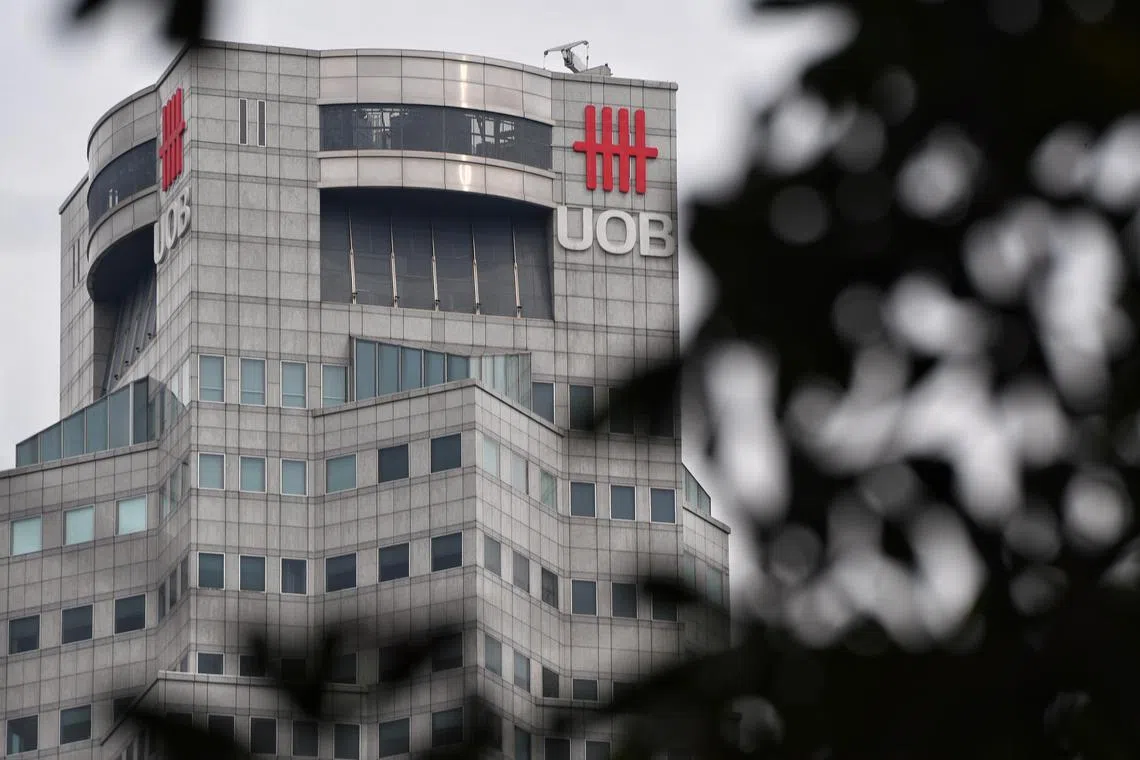UOB’s second-quarter profit up 27% to $1.4 billion; dividend of 85 cents declared
Sign up now: Get ST's newsletters delivered to your inbox

Excluding one-off Citigroup integration expenses, UOB's core net profit rose 35 per cent to $1.51 billion.
PHOTO: ST FILE
Follow topic:
SINGAPORE – UOB’s earnings in the second quarter continued to get a lift from high interest rates and were also buoyed by a rebound in income from customer-related treasury, trading and liquidity management activities.
This comes even as it set aside more allowances for potential bad loans amid economic uncertainty and for a specific corporate account from Thailand’s manufacturing sector.
UOB also lowered its fee income growth forecast for 2023, signalling a more challenging outlook. Fee income is likely to expand at a high single-digit percentage in 2023, chief executive Wee Ee Cheong said on Thursday in a presentation on the bank’s results. This is down from the double-digit growth projected last quarter.
Mr Wee reiterated his forecast for low to mid single-digit loan growth in 2023.
The bank declared an interim dividend of 85 cents a share, up from 60 cents in the same quarter in 2022. This represents a payout ratio of approximately 49 per cent.
The net profit of Singapore’s third-largest bank rose 27 per cent to $1.42 billion, from $1.11 billion in the same period in 2022, in line with the $1.43 billion forecast by analysts in a Refinitiv poll.
It included one-off expenses related to its acquisition of Citigroup’s Malaysia, Thailand and Vietnam consumer banking business.
Mr Wee said the bank expects the Asean region to stay relatively resilient, adding: “Growth will be supported by a more moderate interest rate environment in this region and a pickup in tourism and demand for services.”
A bright spot came from net new money inflows to the tune of $12 billion in the year to date. This brought the bank’s total assets under management (AUM) to $165 billion, up 19 per cent year on year.
“AUM stayed with us, which is a good thing, as we can use the money to fund our loans and deposits… But it is still a very uncertain market (for investors),” said Mr Wee when asked about the outlook for wealth fees.
Group chief financial officer Lee Wai Fai said some of the money came from family offices, but the private banking business has also drawn in more active high-net-worth customers.
“We are confident that although we are behind (in) the market, and we will have to catch up… the private bank will add to (our margins) going forward,” he said.
Giving an update on the Citigroup acquisition, Mr Lee said the bank now has 7.3 million customers in the region. It expects to exceed eight million by the end of 2023 after Citi’s Indonesia business gets integrated into UOB’s network.
There are “huge opportunities” for the bank to cross-sell its products, said Mr Lee, noting that Citi’s portfolio is heavy on unsecured lending such as cards, while UOB is strong in secured lending and wealth.
UOB’s second-quarter net interest income rose 31 per cent year on year to $2.44 billion, led by a 45 basis point expansion in net interest margin – a key gauge of a lender’s profitability – to 2.12 per cent.
Mr Wee said the bank’s margins could “inch a bit higher” following the US Federal Reserve’s latest rate hike, by a quarter of a percentage point, on Wednesday.
Loans grew 1 per cent both from the previous quarter and on a constant currency basis from a year ago. Mr Lee said: “We are hopeful of a stronger second half, although that is highly dependent on the recovery of China and the stability of the interest rate outlook.”
Loan-related and wealth management fees were softer compared with a year ago as investor sentiments remained subdued. These declines were partly offset by an increase in card fees.
Asked about the boost to UOB’s cards business from its pre-sale ticket deal
Nonetheless, Mr Wee noted that the deal has given UOB an advantage when it comes to competing with big domestic banks in the region. Singapore is the only stop in Swift’s Eras Tour in South-east Asia.
Other non-interest income more than doubled to $581 million, from $273 million a year ago, on higher customer-related treasury income and strong performance from trading and liquidity management activities in the second quarter.
Meanwhile, the bank saw higher credit costs on loans as it made more pre-emptive provisions, with total allowances rising to $365 million. It said: “Outside of a specific exposure, credit costs remained stable. The group continues to maintain healthy provision buffers to cushion against uncertainties.”
Asset quality remained stable with its non-performing loan ratio improving to 1.6 per cent, down from 1.7 per cent a year ago.
Meanwhile, the level of current and savings account deposits – a cheap source of funds for banks – was stable in the second quarter compared with the first. This came after four quarters of decline in 2022 as customers flocked to fixed deposits amid high interest rates.
UOB’s results kick off earnings season for local lenders. DBS Bank will report its numbers on Aug 3, and OCBC Bank on Aug 4.
UOB closed up 23 cents, or 0.8 per cent, at $28.92 on Thursday. DBS rose 60 cents, or 1.8 per cent, to $33.76 and OCBC 23 cents, or 1.8 per cent, to $13.07.


